
Tags
Share
As many leaders know, running a high-performance call center requires more than just managing day-to-day interactions. It’s about staying ahead of evolving customer expectations, rapidly advancing technologies, and an increasingly complex service landscape—just to name a few.
Today, the pressure is greater than ever to balance efficiency with exceptional service while navigating issues like high agent turnover, omnichannel complexity, and the demands of remote work.
You’ve likely seen firsthand how outdated systems, poor knowledge management, and a lack of personalization can erode customer trust and lead to inefficiencies that ultimately affect your business’ bottom line.
So, how can contact center leaders drive continuous improvement, empower agents, and protect sensitive customer data, all while delivering seamless customer experiences across multiple touchpoints?
In this guide, we’ll walk you through how we approach this challenge in our own contact centers.
10 common call center challenges and solutions
The job of a call center agent—or a manager leading a contact center team—is more complex than ever. In 2025, customer expectations are higher, service channels are more fragmented, and new Ai technologies are changing how work gets done at every level.
While Ai has brought major gains in productivity, speed, and self-service, it’s also introduced a new set of expectations: agents are now expected to resolve issues faster, personalize every interaction, and juggle more tools in real time. Add to that a hybrid workforce, rapidly changing business models, and new data regulations, and it’s no surprise that leaders are reevaluating what “great service” looks like.
Here are 10 of the most common call center challenges in 2025—we’ll get into more specific solutions and tips for each one below:
High call volume and long wait times
Agent fatigue and turnover
Poor knowledge management
Lack of personalization
Inconsistent service quality
Managing remote teams
Fragmented tech stack
Security and compliance risks
Low visibility into performance
Disconnected omnichannel experiences
1. Excessive call volume and long wait times
Problem: Call volumes remain high in 2025, even with more self-service tools available. As customers use Ai for simpler issues, the calls that do reach your agents tend to be more complex—and time-consuming.
Solution: Ai-first call deflection strategies are key. Use generative Ai-powered virtual agents and Ai IVR to resolve simple requests like password resets, account updates, or order tracking—freeing up your agents for higher-priority issues. You can also use dynamic callback systems to reduce wait times.
Dialpad Support, for example, comes with an easy-to-use chatbot builder that lets you drag and drop a conversational flow together in just a few minutes:
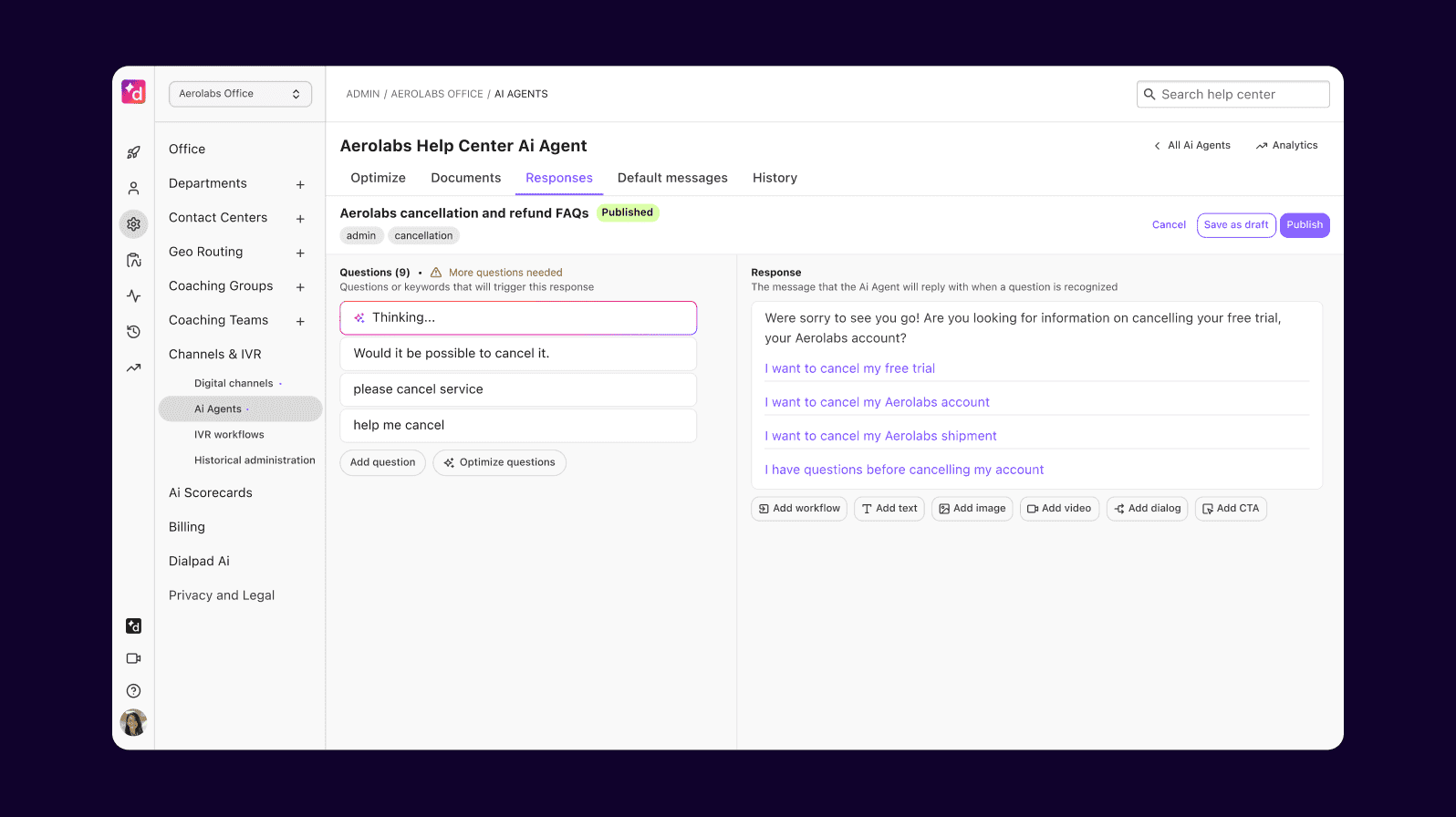
2. Agent fatigue and turnover
Problem: Even in a hybrid world, contact centers still face burnout and attrition—especially as agents deal with more emotionally charged or complex calls. The “silent burnout” or “quiet quitting” effect is growing, where employees stay but disengage.
Solution: Make it easier for your agents to do their jobs—this is a key, but often overlooked, part of contact center management. Offering incentives and rewards are important too, as well as an employee engagement program that includes career development opportunities and a positive work environment. But agents have difficult jobs. Not only do they have to be able to answer every type of question quickly and know the ins and outs of all your products, they also have to manage customers’ anger and demands. Help them by giving them the tools they need.
3. Poor knowledge management
Problem: On a related note, call center agents often struggle with poor knowledge management, meaning they lack easy access to accurate, up-to-date information to help customers. This is an especially common legacy contact center challenge in organizations where employee turnover over time has created gaps in processes and institutional knowledge. Without a centralized and regularly updated knowledge base, agents will waste valuable time searching for information, leading to longer call handling times, inconsistent answers—and frustrated customers.
Solution: Implement a centralized, well-organized knowledge management system that’s easy to update and navigate. Make sure it includes a comprehensive database of FAQs, details about your products or services, troubleshooting guides, and policies. Regularly review and update this repository to keep it relevant.
Even better, invest in Ai-powered knowledge assistants that surface real-time, context-aware recommendations during live conversations. Centralize your knowledge base and ensure it’s maintained regularly, with built-in versioning and feedback loops. Here’s an example of how that looks with Dialpad’s Ai Live Coach, which automatically detects when certain keywords are spoken and can pull up relevant content and links from your connected knowledge bases:
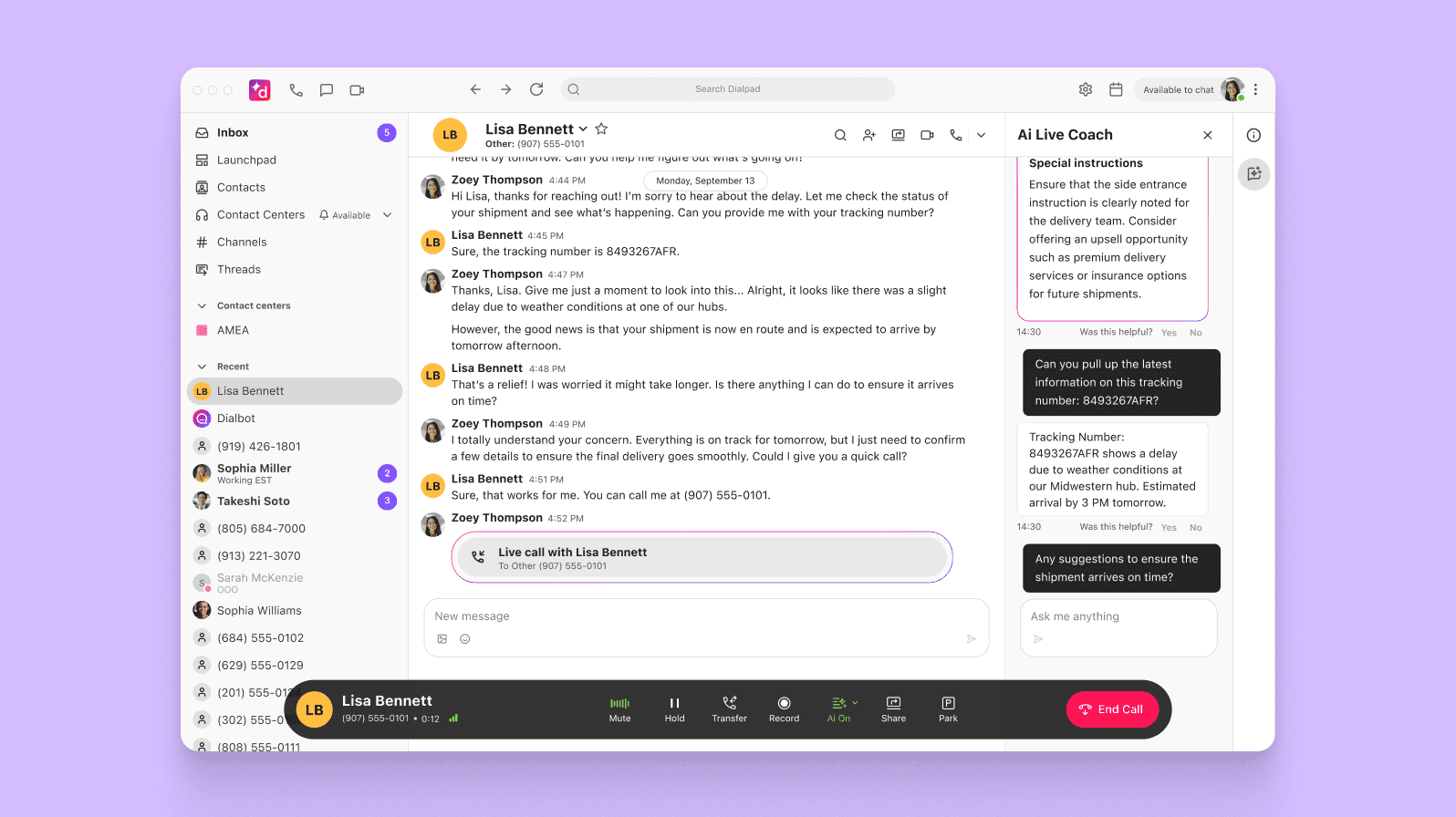
And best of all? This will help with challenge #2 (agent fatigue) as well.
4. Lack of personalization
Problem: Generic, one-size-fits-all service is no longer acceptable for consumers today. The vast majority (71%) expect companies to provide personalized interactions, and 76% of them get frustrated when it doesn’t happen. Today, personalization is table stakes, with customers expecting agents to know their history and preferences without them having to constantly repeat themselves.
Solution: Start by integrating your CRM (customer relationship management) platform into your agents’ tech stack so they can instantly access a unified view of each customer’s history across channels. This includes past conversations, purchases, and even sentiment from previous interactions. With this context, both agents and virtual assistants can tailor conversations in real time.
Dialpad Support, for example, integrates with CRMs like Salesforce, HubSpot, and Copper to embed its dialer right into those CRMs, automatically log calls for agents, and even pop up an Ai Live Coach during conversations:

But personalization isn’t just about reactive service anymore—it’s about proactive, intelligent automation. Dialpad is also building out new agentic Ai features that deliver hyper-personalized, autonomous end-to-end experiences without human intervention.
For example:
An order tracking Ai agent can automatically authenticate the customer, access order systems, and return a detailed shipping update with estimated delivery time—no need to speak to a rep.
An appointment management Ai agent can identify a customer, surface available time slots, reschedule appointments, and push updates to internal systems instantly.
These agentic workflows don’t just personalize service—they accelerate it, giving customers the answers they need before they even think to ask.
5. Inconsistent quality and coaching at scale
Problem: Maintaining a consistently high standard of customer service can be difficult, especially when you have agents with varying skills and experiences. (For smaller businesses with less mature team structures, this is a particularly common SMB contact center challenge.) High call center attrition only adds to the problem, and even seasoned agents may drift from best practices without realizing it. On top of that, traditional QA processes, where supervisors manually review a fraction of calls, just can’t keep up with today’s call volumes.
Solution: Start by using Ai to scale your quality assurance efforts. For example, Dialpad Ai can automatically analyze up to 100% of calls and infer a CSAT score without customers needing to fill out surveys.
Then there’s the Ai Scorecards feature, which removes the need for random call sampling by auto-generating QA assessments across your team. Managers can instantly see trends, such as which agents are skipping critical discovery questions or when they need help navigating difficult calls:
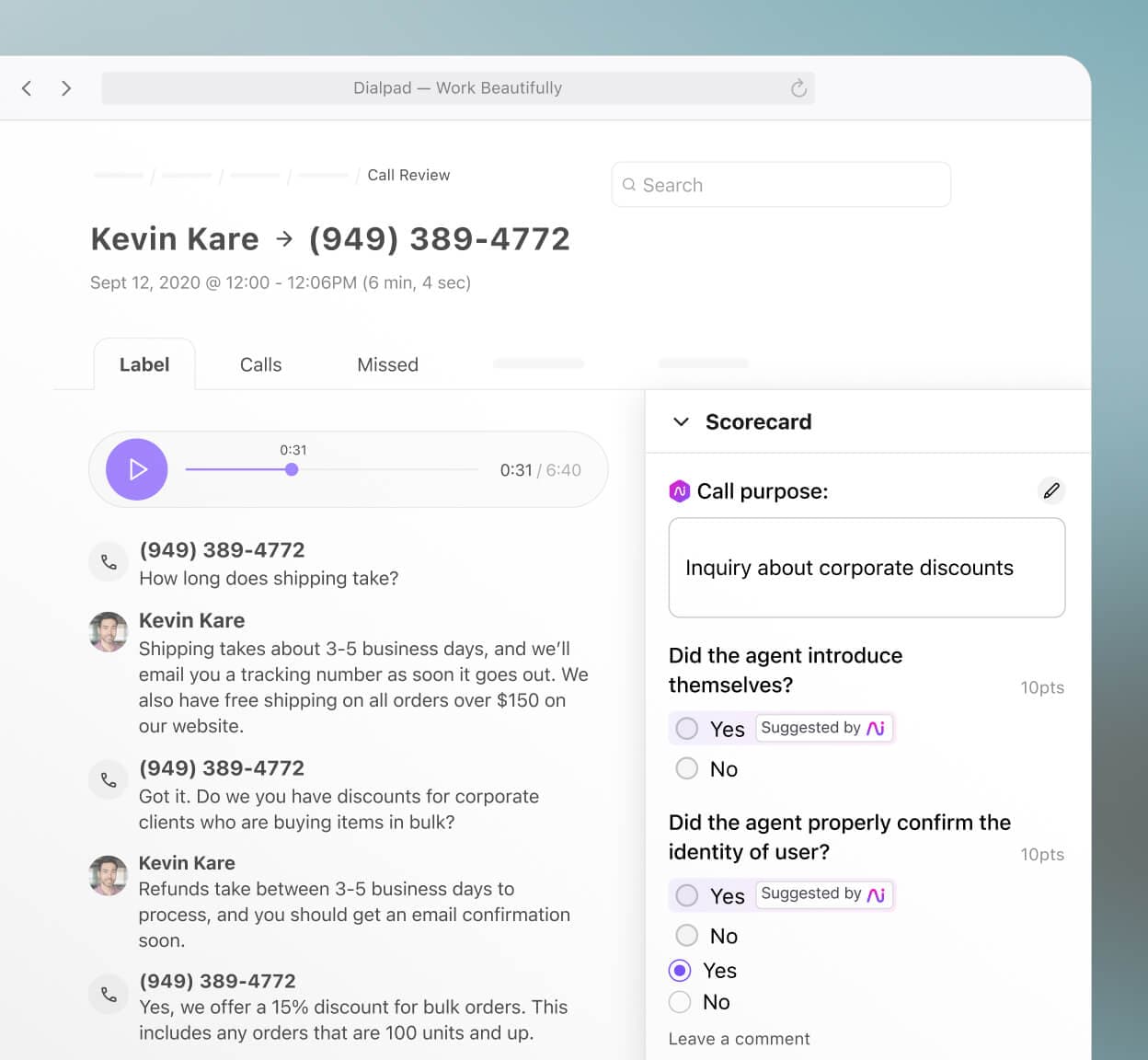
For more impactful coaching, schedule short, frequent 1:1 sessions using real conversation data. Create a shared dashboard that includes Ai-powered highlights, and encourage agents to self-review their own calls with annotations or feedback goals. (This also helps build a culture of continuous improvement.)
6. Managing a distributed, hybrid workforce
Problem: Managing hybrid or fully remote teams is now the norm—but with it comes new obstacles around engagement, visibility, and accountability. One of the biggest challenges for call center managers today is, without a doubt, a result of remote work. Without face-to-face interactions, it's harder to spot burnout, coach in the moment, or build team cohesion.
Solution: Use a unified communications platform that lets your team message, meet, and call from anywhere—within one system. This will help cut down on information silos and strengthens real-time collaboration.
Dialpad Support, for instance, lets supervisors view live agent activity dashboards and even jump into calls to listen, whisper, or barge in when needed. You can also use the built-in analytics to track talk time, idle time, and call volume trends, helping managers proactively spot burnout or disengagement.
7. Disconnected or outdated tech stacks
Problem: Many contact centers still rely on patchwork systems—one tool for calls, another for chat, another for analytics, and yet another for coaching. This leads to context-switching, slow responses, and increased error rates.
Solution: Consolidate your stack with an all-in-one CCaaS (Contact Center as a Service) or cloud contact center solution that includes calling, messaging, coaching, and real-time analytics in one interface. This minimizes switching between apps and allows your agents to focus entirely on the customer experience.
Look for tools that natively integrate with your existing systems—like your CRM, ticketing platform, or workforce management software—so data gets automatically synced between them.
8. Data security and compliance risk
Problem: In 2024, the global average cost of a data breach was $4.88M, a 10% increase over the past year. With data breaches and cybersecurity threats becoming more common, protecting customer and company information is a critical concern for call centers.
Solution: Invest in contact center software that has robust cybersecurity measures, including enterprise-grade encryption, secure access controls, and regular security audits. Train your agents regularly on the latest data protection best practices and ensure call center compliance with relevant regulations, especially if you work in a tightly regulated industry like healthcare or finance.
9. Limited visibility into performance and customer sentiment
Problem: One of the biggest challenges for call center managers is measuring performance effectively because of the complexity of tracking the right metrics across various agents (even more so if they’re working remotely), teams, and customer interactions.
Solution: Go beyond surface-level KPIs and use Ai to glean both quantitative and qualitative insights. As I mentioned earlier, Dialpad‘s Ai CSAT feature uses Ai to infer CSAT scores on up to 100% of calls—helping you get a much fuller picture even if customers don’t fill out surveys:
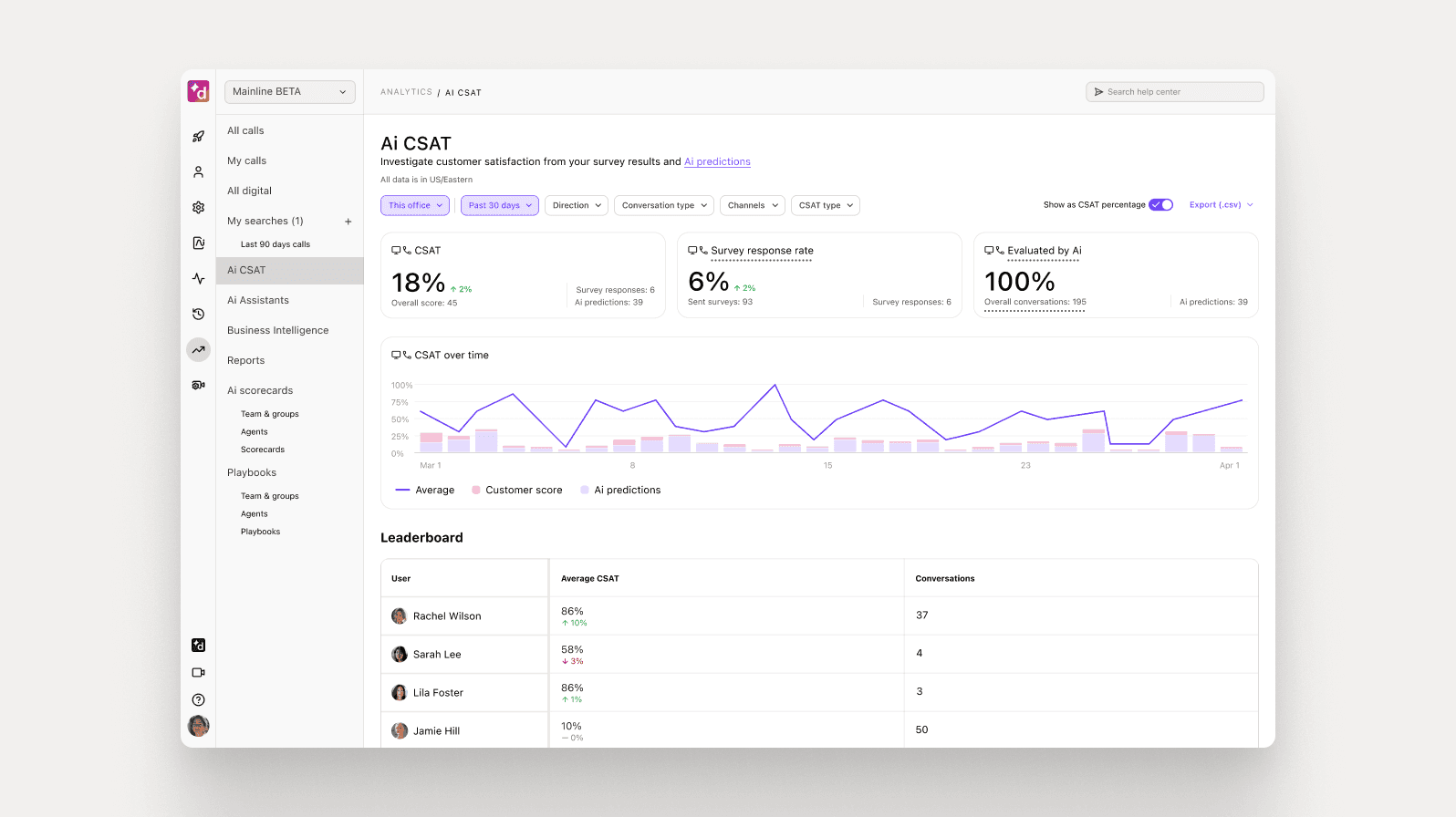
Ai’s ability to analyze conversations can be helpful in many other ways. For example, in Dialpad we can set up “Custom Moments” to track different keywords (like “refund” or “money back” if we want to see churn-related trends):
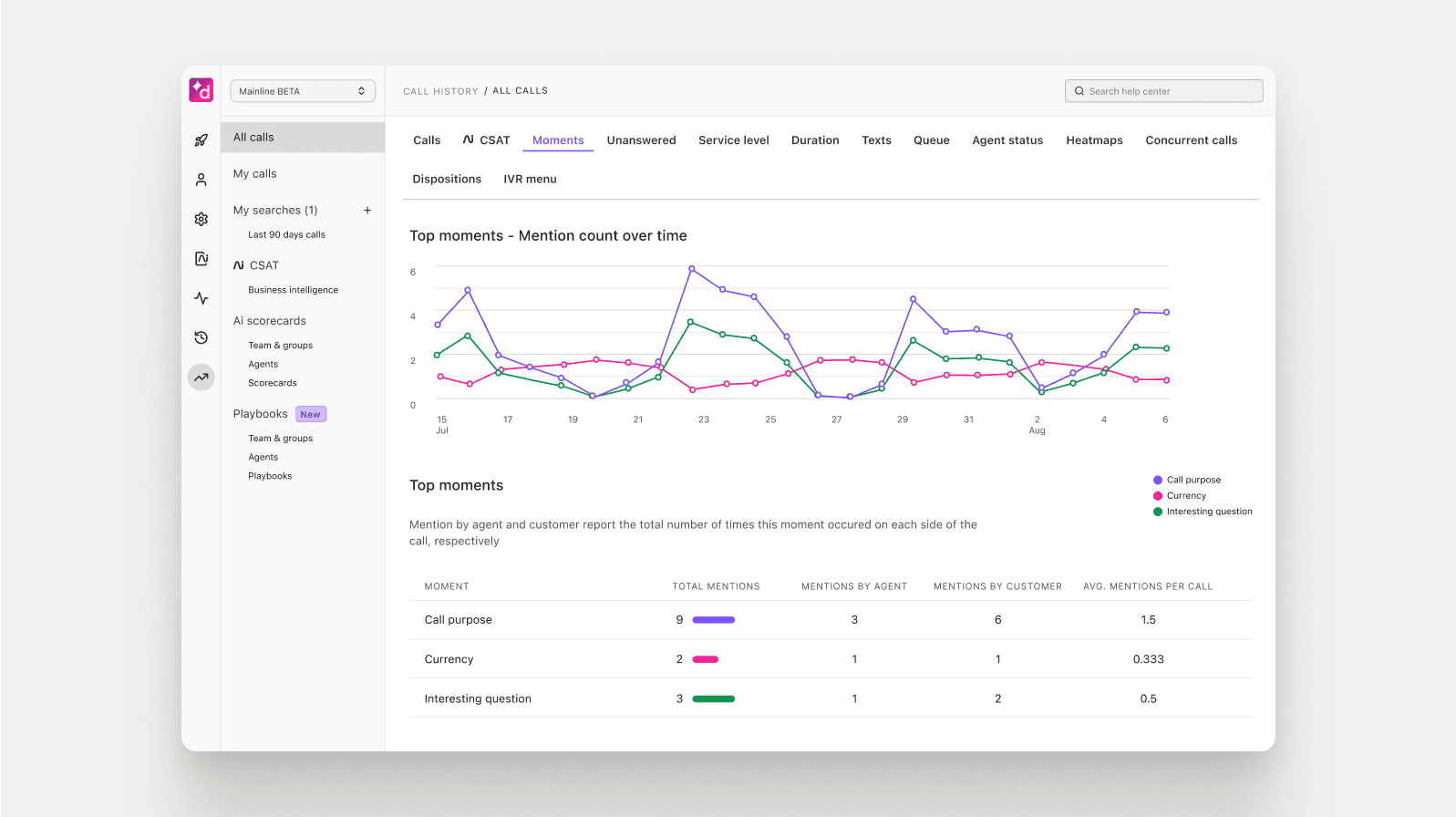
This helps our managers coach more proactively, address emerging customer pain points, and tie call center performance back to strategic goals like retention or revenue.
10. Navigating omnichannel communication
Problem: Today’s customers jump between channels—starting a chat, switching to email, and ending with a phone call. But too many contact centers still silo these interactions, which forces agents to piece together context manually or makes it easy for them to miss key details altogether.
Solution: If you’re not already using an omnichannel customer service platform, it’s time to consider switching to one. Of course, if your customers are only reaching out to you through a single channel (like over the phone or email), then feel free to skip this one.
Otherwise, invest in an omnichannel platform that consolidates all customer interactions into a single view. This allows agents to follow the full conversation history across channels without toggling between apps. Whether your customers are texting, calling, messaging on WhatsApp, or reaching out via social media, agents should be able to respond from one place—with full context.
Dialpad enables this with a unified platform for voice, SMS, live chat, and more—all embedded with Ai. That means faster responses, less confusion, and a better experience for both agents and customers:
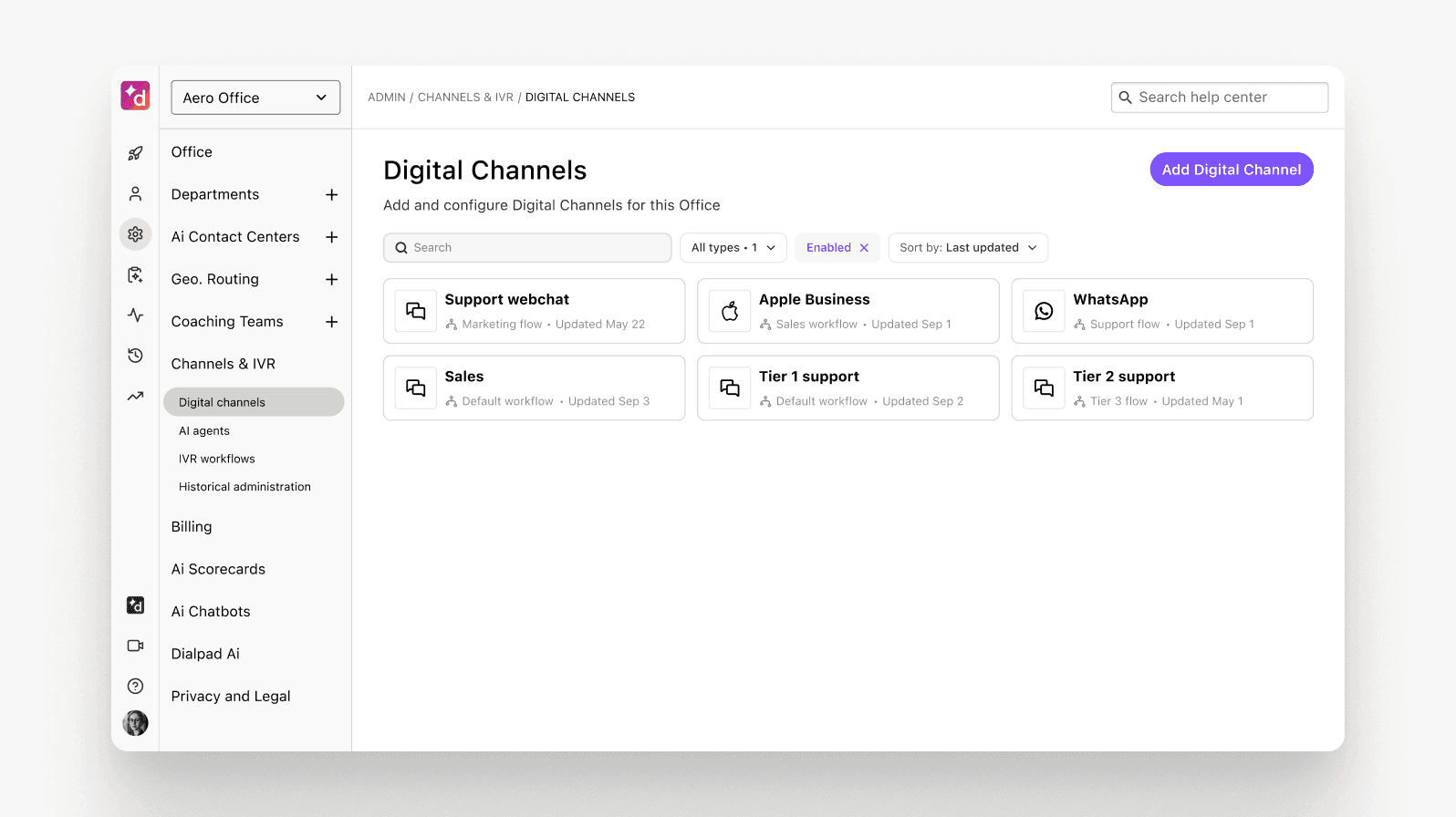
What to do when major contact center challenges occur
When major issues strike—whether it's a sudden outage, compliance incident, or extreme call spike—having a reliable strategy (and the right partner) can make all the difference. Here's how a trusted contact center provider can help you navigate through high-stakes moments:
Ensure backup communication options are built in. A dependable provider will offer built-in redundancy and support for multiple channels (like voice, SMS, and chat), so you can quickly shift your customer service without downtime or disruption.
Lean on their support team during incidents. A trusted contact center partner should provide 24/7 support and escalation paths when things go wrong. Make sure your provider offers clear SLAs and fast access to technical support teams in emergencies.
Work with a partner who prioritizes compliance and resilience. In industries like healthcare or finance, any misstep can be costly. Your provider should have a strong security posture, regular audits, and the infrastructure to keep your operations compliant—even under stress. Learn more about how Dialpad keeps your company’s and customers’ data safe.
The importance of effective contact center management
An effective call center is crucial because it directly impacts customer satisfaction, brand reputation, and operational efficiency.
Efficient call centers are typically more adept at providing good customer experiences and timely and accurate support, which leads to increased customer loyalty and positive word-of-mouth. Ultimately, that results in more streamlined operations, lower costs and higher revenues.
Overcome contact center challenges with Dialpad Support
The challenges faced by call centers are complex and still evolving, driven by technological advancements and changing customer expectations.
But with the right strategies and tools, even major call center problems can be turned into opportunities for growth and efficiency. By leveraging Ai and automation, contact center leaders can tackle key issues like agent turnover, challenging customer questions, and the need for effective performance measurement.
Struggling with call center challenges?
Learn more about how call center teams are using Dialpad Support to overcome QA issues, coaching challenges, and more. Book a product tour now!

